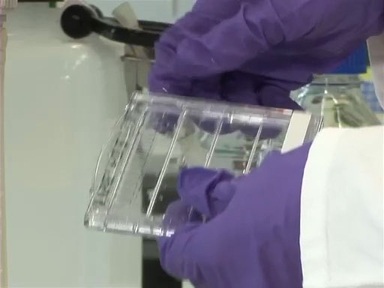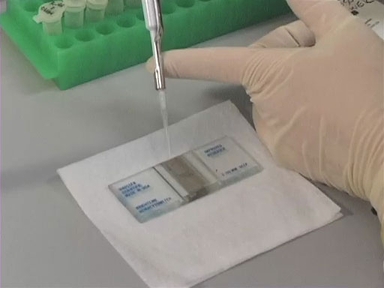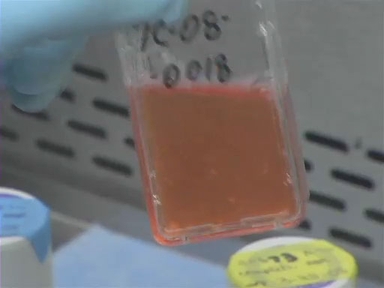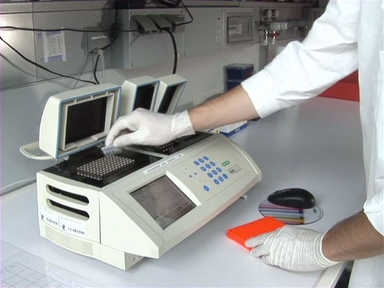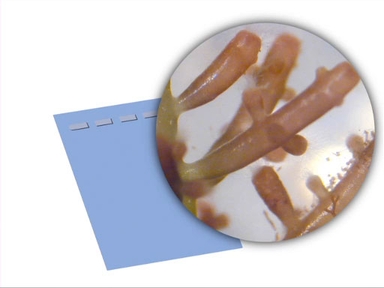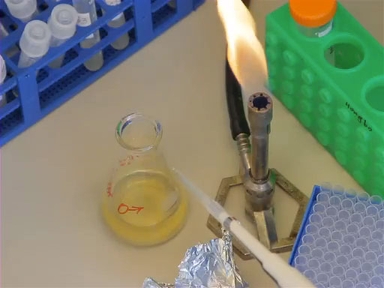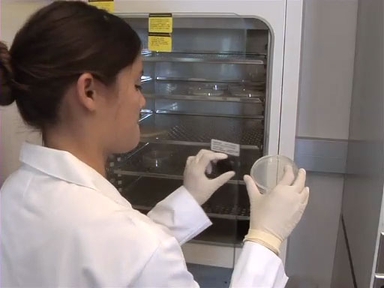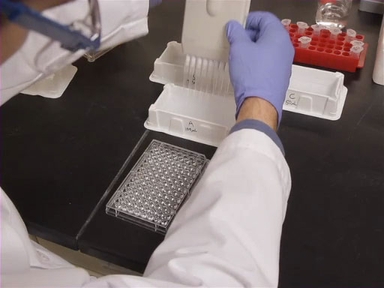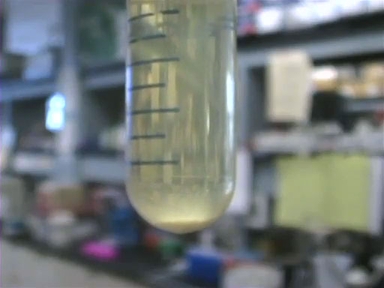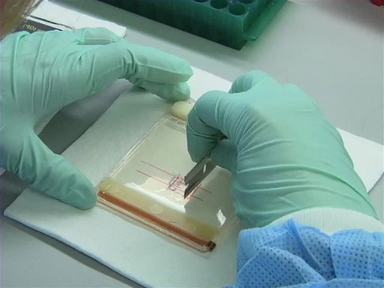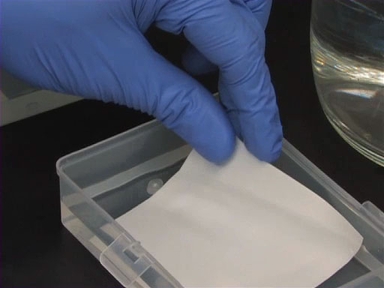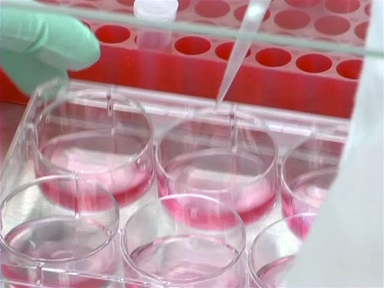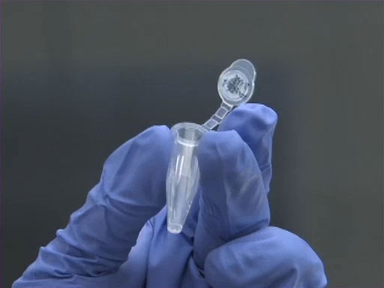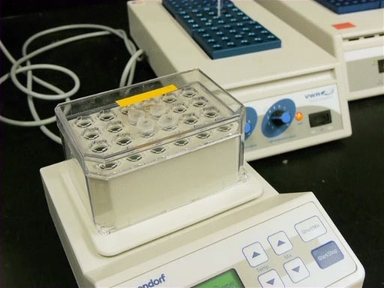SDS-PAGE is a technique used by many researchers to separate mixtures of proteins by size. Successful completion of this technique is an essential first step for many methods of protein analysis, like immunoblotting. By itself, it is a useful tool in assessing protein size and purity.
In order to understand the SDS-PAGE technique, you must first understand its principle components. SDS-PAGE stands for Sodium Dodecyl Sulfate Poly-Acrylamide Gel Electrophoresis. Sodium-Dodecyl Sulfate, the first part of this, or “SDS”, is an anionic detergent. This means that it is composed of a hydrophilic group with a net negative charge and a long hydrophobic chain with neutral charge.
The hydrophobic chain blankets proteins in proportion to their mass at a rate of 1.4 grams of SDS per gram of protein. This provides the proteins with the driving force necessary for size driven separation in an electric field.
Poly-Acrylamide Gel Electrophoresis utilizes a hydrogel made from polyacrylamide. Polyacrylamide is a polymer that forms a very regular matrix through which proteins can move. The more concentrated the gel is, the slower the proteins will traverse across it when exposed to an electric field. The process of using a spatially uniform electric field to influence an objects motion is known as electrophoresis.
SDS-PAGE is performed on proteins isolated from many different sources including cells in culture, tissues, blood, urine, and yeast.
Proteins from these various sources must first be separated from other cellular components using techniques including homogenization and centrifugation, often followed by the use of lysis buffers.
Once the protein is isolated, its concentration is often measured, to ensure equal loading of samples, by comparing the amount of protein in the sample to albumin standards in a Bicinchoninic acid, or BCA, colorimetric assay.
An important step to remember is the addition of the loading buffer. The loading buffer has 3 main functions. First, thanks to SDS and additional reducing agents, it denatures the proteins, which basically means it turns complex protein structures into a linear chain of amino acids. Secondly, it contains glycerin, which ensures that the sample doesn’t float away when it is loaded in the wells of the gel. And finally, most commercial loading buffers include a dye, such as bromophenol blue, which can be tracked to measure the progress of the electrophoresis step.
After adding the loading buffer, the samples need to be mixed and then boiled for 5 minutes. This allows the strong di-sulfide bonds in the proteins to be broken with the help of a reducing agent such as beta-mercaptoethanol. Once all the disulfide bonds are broken SDS can more evenly coat the proteins.
Next, the samples are quickly spun down and are then ready to be loaded into the gel system for electrophoresis.
Before the samples can be loaded, the gel system must first be assembled. This begins with the purchase or fabrication of a polyacrylamide gel. Premade gels are becoming more and more popular because acrylimide is neurotoxic and can cause brain damage. The gel cassette contains wells that are used to load the samples.
Once the gels are secured into place, the inner and outer chambers are filled with a buffer that contains the same concentration of ions used to make the gels. This creates an electrical circuit that passes seamlessly from the cathode, through the gel and into the anode.
Next, molecular weight ladders are typically loaded into the gel, followed by the samples. As the gel runs, the ladder will spread and create visible protein bands of known sizes. At the final steps, these bands can be used to calculate each protein’s size.
Once all the samples are loaded, the positive and negative terminals on the gel box are connected to a power source capable of maintaining a constant voltage for a long period of time. Gels are typically started at around 60V until the entire sample has entered the gel region called the “stacking gel”. Then, the voltage is increased to around 200V for 30 minutes to 1 hour depending on the size and concentration of the gel and the size of the protein of interest.
When electrophoresis is complete, the cassette is removed and opened to expose the gel. The gel can then be stained with a typical protein stain, such as coomassie blue or silver stain, to visualize the protein bands within the gel. Coomassie stain can detect bands with as little as 50 nanograms of protein, whereas silver stain can detect bands with as little as 1 nanogram of protein.
In two-dimensional gel electrophoresis, samples are separated by two separate properties on gels, one dimension at a time. First, samples are loaded and arranged according to their isoelectric points on localized pH gradient strips. The proteins in the strip are then denatured and are placed on top of a typical polyacrylamide gel where they are secured in place with fresh gel solution. Then, second dimension separation is performed by SDS-PAGE.
While isoelectric focusing isn’t the only option for 2-D gel electrophoresis, it is the most common. Two-dimensional gel electrophoresis is an invaluable tool that provides insights into protein complexes and sub-organelle organization.
After running the gel, a very common next step is to transfer the proteins from the gel onto a membrane made of PVDF or nylon for analysis. You can then use specific antibodies to probe the membrane and look for proteins of interest. Shown here are typical immunoblot results where the researcher used 3 different signal amplification techniques to determine which best shows the presence of the Pit-1 protein throughout a number of serial dilutions.
You’ve just watched JoVE’s video on protein separation using SDS-PAGE. You should now understand the steps involved in resolving a protein by size using this powerful technique. As always, thanks for watching!
